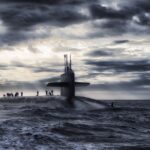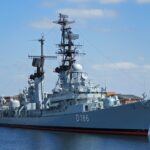The Evolution of Naval Warfare: From Sailboats to Nuclear Submarines
Naval warfare has undergone a dramatic evolution over the centuries, from the days of sailboats and cannons to modern nuclear submarines and aircraft carriers. This evolution has been driven by technological advancements, changing strategies, and geopolitical factors. Let’s take a closer look at how naval warfare has evolved over time.
Ancient Naval Warfare
In ancient times, naval warfare was limited by the capabilities of sailboats and oars. The primary weapons were cannons, archers, and ramming tactics. Naval battles were often fought close to land, with ships engaging in close combat. The speed and maneuverability of ships were crucial in determining the outcome of battles.
One of the most famous naval battles of antiquity was the Battle of Salamis in 480 BC, where the Greek navy defeated the larger Persian fleet using superior tactics and knowledge of the local waters. This battle demonstrated the importance of strategy and planning in naval warfare.
The Age of Sail
The introduction of sailboats revolutionized naval warfare in the Middle Ages. Ships could now travel greater distances and engage in long-range combat. The development of cannons and guns also transformed the nature of naval battles. The ability to fire from a distance gave warships a significant advantage over enemy vessels.
During the Age of Sail, naval powers such as Britain, France, and Spain competed for dominance of the seas. The invention of the steam engine in the 19th century further transformed naval warfare, allowing ships to sail faster and more efficiently. Steamships replaced sailboats as the primary means of naval transportation.
World War I and World War II
The advent of submarines, airplanes, and radar systems during World War I and World War II marked a significant turning point in naval warfare. Submarines enabled stealth attacks and underwater warfare, while aircraft carriers allowed for the deployment of planes over long distances. Radar systems improved navigation and detection of enemy ships.
The Battle of Midway in 1942 was a pivotal moment in World War II, where the United States defeated the Japanese navy in a decisive battle. The use of aircraft carriers and advanced aerial tactics demonstrated the importance of air power in modern naval warfare. The Battle of Midway highlighted the role of technology and innovation in determining the outcome of naval battles.
The Cold War and Nuclear Submarines
The Cold War era saw the development of nuclear submarines and ballistic missile submarines. These submarines were equipped with nuclear weapons and could remain submerged for extended periods, making them a formidable force in naval warfare. The threat of mutually assured destruction (MAD) deterred major naval conflicts between the United States and the Soviet Union during this period.
Nuclear submarines played a critical role in the Cuban Missile Crisis in 1962 when a Soviet submarine was discovered near Cuba with nuclear missiles onboard. The crisis was resolved peacefully, but it underscored the danger of nuclear weapons in the hands of naval forces. The development of nuclear submarines ushered in a new era of underwater warfare and strategic deterrence.
Modern Naval Warfare
Today, naval warfare is characterized by the use of advanced technology, such as stealth aircraft, drones, and cyber warfare. Modern navies are equipped with sophisticated weapons systems and communication networks, allowing for real-time coordination and intelligence gathering. The rise of asymmetric warfare and non-state actors has also challenged traditional naval strategies.
Naval powers such as the United States, China, and Russia continue to invest in naval capabilities, including aircraft carriers, destroyers, and submarines. The use of unmanned surface vessels and autonomous underwater vehicles is also becoming more prevalent in naval operations. The future of naval warfare may involve a combination of manned and unmanned systems working together in coordination.
Conclusion
The evolution of naval warfare from sailboats to nuclear submarines has been driven by technological advancements and changing geopolitical realities. Navies have adapted to new threats and challenges, from ancient cannon warfare to modern cyber attacks. The development of nuclear submarines and aircraft carriers has transformed the nature of naval warfare, making it more complex and interconnected than ever before.
As we look to the future, the role of technology and innovation will continue to shape naval warfare. From underwater drones to hypersonic missiles, navies are exploring new ways to maintain their maritime superiority. The lessons of history remind us that naval warfare is a dynamic and ever-changing field, where adaptability and strategy are key to success.


